
Return to Gallery
Display Contents
Beaker burials on Thanet - Part 2:
An overview
Introduction
Other possible burials
Coastal erosion
Kent's Beaker burials
Distribution
Other Beaker sherds
Lord of the Manor
Monkton-Minster A253
Form and date
Burial type
Orientation
Grave-good placement
Ritual breakage
Coffin-structures
Settlements
Significance
An overview
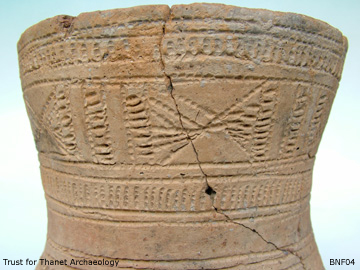
Feature scales in 0.5 metre divisions
Twelve certain Beaker burials are known from Thanet, with a probable total of 13. This figure is based on burials which have actually produced a Beaker. It does not include burials which are likely to be contemporary with, or are closely associated with other Beaker burials and are therefore likely to be of the 'Beaker Period'.
Beaker period graves have been found on the Monkton-Minster A253 excavations. Here several burials other than those already mentioned in the 'Part 1' list are likely to be dated to the Beaker Period either by association or the inclusion of similar grave goods.
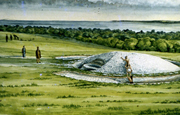
Roundbarrow
By Len Jay
There is some evidence to suggest that several other Beaker burials may have been discovered on the Isle of Thanet.
Two barrows excavated at Lord of the Manor (LOM VIII) and East Northdown have produced Beaker pottery from their enclosing ring ditches but not from graves. These sherds may represent plough disrupted Beaker burials.
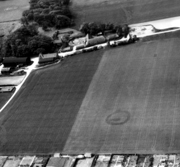
An aerial photograph of the ring-ditch monument at East Northdown showing as a cropmark
Photographer unknown
Aerial photographs of this area taken fortuitously before major house-building revealed a wide variety of different cropmarks indicating both settlements and likely burial monuments
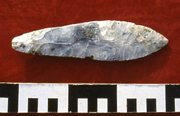
The Sergent Dagger
Photo by TTA
Photographer unknown
Click here to link to a page which describes and discusses these finds in more detail.
In the search for a figure for the total number of Beaker burials on Thanet one point to consider is the extent of the erosion of Thanet’s coastline over the last 4000 years.
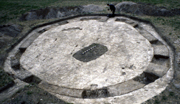
Manston Runway Approach roundbarrow
Photo by TAU
Photographer unknown
At present it is not clear exactly how many Beaker burials have been found in
Paul Ashbee (2005) notes that 36 Beakers have been found in
All but one of the Beakers from Thanet have been found since 1970 and there have no doubt been other Kentish examples in the last 35 years.
It seems reasonable to conclude at the
moment however that the
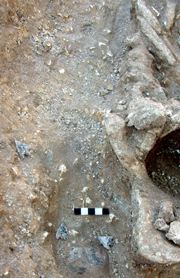
QEQM Margate arrowheads
Photo by Susan Deacon (TTA)
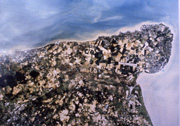
The Isle of Thanet
Copyright unknown
Thanet’s Beaker burials have been found across the whole
The
distribution pattern may be seen as coastal, but it has been pointed
out that nowhere on Thanet is very far
from the coast (Moody pers comm.)! A coastal bias of
distribution can be more
readily
seen in the rest of
This distribution probably reflects
areas favoured for
settlement. However, if it indicates a particular propensity for
a marginal or
water-side location for the siting
of
Beaker burials, it may be one cause for their apparent frequency on Thanet.
If the Island location itself
represented a
particular attraction this could
also be a significant factor in explaining the concentration of roundbarrow burial monuments on Thanet. The
location may have attracted additional burials from the
It is interesting to note that in

Fingernail-rusticated Beaker sherds from QEQM Margate
Across Thanet isolated or small groups of Beaker sherds are occasionally discovered. These may represent burials destroyed by later ploughing, or perhaps suggest evidence of domestic settlements.
Click here for further details on these sites.
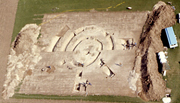
Lord of the Manor I
Photo by TAU
Photographer unknown
The concentration of Beaker sherds at the circular-ditched monuments at Lord of the Manor is worthy of note.
The multi-phased ‘Lord of the Manor I’ produced 49 sherds from at least 7 Beaker vessels and probably started life as a single-ditched Late Neolithic Henge monument. The Beaker sherds were found in a secondary, ‘refurbishment’ phase of activity at the site.
The Lord of the Manor excavations revealed up to six small Hengi-form enclosures, which were probably first constructed in the Mid-Late Neolithic. All Beaker sherds were found in later, 'Secondary' phases of these features. Regionally, this type of monument appears to be confined to Thanet (Nigel Macpherson Grant).
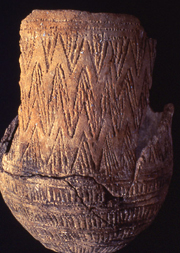
Monkton-Minster
Grave 3035 Beaker
Canterbury Archaeological Trust
The excavations on this site also produced a significant quantity of Beaker sherds.
The current road runs along a chalk ridge which commands a great view to mainland Kent over the former Wantsum Channel. This ridge was likely the route of an ancient Prehistoric trackway and ultimately leads to the Lord of the Manor and Chilton area to the east.
Extensive archaeological remains have been discovered along this road through excavation and aerial photography.
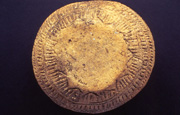
Monkton-Minster
Grave 3035 Beaker base
Canterbury Archaeological Trust
Five Thanet Beakers have associated radiocarbon-dates (Manston, Cottington Lane, Monkton-Minster Grave 751, North Foreland and QEQM Margate). Overall they cover a period of 580 years from 2460-1880 BC. The dates of all but the QEQM Beaker overlap in such a way that all could have been in existence together around the year 2130 BC.
In general the Beakers from Thanet, like those from the rest of
The dates obtained for the Manston and North Foreland Beakers are most interesting, for though they are vessels of similar style (both 'Long-Necked') their dates overlap by only 10 years (at 2140-2130 BC). They are both within the range expected for these vessels however.
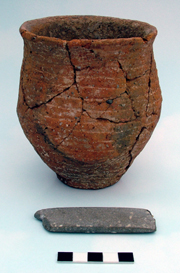
The 'Early Style' Beaker and stone wristguard from
St. Peter's
The North Foreland 'Long-Necked' Beaker has produced an earlier date than that traditionally expected for its form. This was thought to be around 1900-1700 BC by some estimates, yet dates obtained from other vessels around the country show that at 2350-2130 BC the North Foreland vessel is still within the broad range for its type, though it lies at the earlier end of it.
The conundrum over some of the Beaker dates is highlighted by the 'Early Style' Beaker discovered at South Dumpton Down. This Beaker was located stratigraphically above (and therefore later than) sherds from a Food Vessel. These are usually dated from around 2000-1700 BC (Macpherson Grant pers comm.), which is within the Later Beaker Period.
The dominance of the 'Early Style' Beakers present here (and in the rest of Kent) could reflect the initial stages of the spread of this new vessel form derived from the Continent. Potting conservatism (Macpherson Grant) may then have resulted in the long-lived nature of some of these Early forms.
It seems unlikely that long term curation over many generations could have resulted in most of these 'Early Style' Thanet vessels producing later than expected dates.
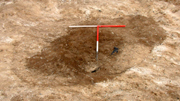
QEQM Margate flat-grave
showing a coffin-structure soil-mark
This is particularly visible around the undisturbed left-hand side of the grave)
Photo by TTA
Eight of the 12 Beaker inhumations discovered on Thanet occur as flat-graves. Only 4 are certain to have been within what is likely to have been a much more visibly impressive roundbarrow monument.
That is not to say that the flat-graves were not marked in some way above ground; they may still have had a small mound or a non-invasive structure as a marker, but one which left no archaeological trace. The circumstances of the QEQM Beaker grave being cut into but not fundamentally disturbed by what is likely to have been a virtually contemporary secondary burial suggests that it may well have had a visible presence above ground.
Clarke's national survey (1970) revealed a 50/50 proportion of barrow inhumations against the flat-grave burial-rite. Research on North French Beaker burials by Peter Clark has revealed that they are dominated by the use of the flat-grave rite (pers comm.).
Several of the Beaker graves feature multiple burials or contain disarticulated bones from other individuals. Such a practice may have it roots in the ancestral Neolithic tradition of communal burial and reflect the evolution of the single inhumation rite into the Bronze Age.
One possible significant trend is that out of seven known cases (III, IV, VI, VII, ***, XI and XII) five of the burials have been laid facing east (III, VI, VII, *** and XII).
This does not include the South Dumpton Down burial (V). This Beaker was most closely associated with a west facing infant (Burial 4), but might also have accompanied a south-easterly facing adult (Burial 6).
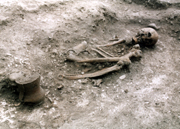
North Foreland Beaker burial
Where information is currently available, it can be seen that the Beakers are placed in a variety of positions within the grave. The pots have been found behind the head (XII) or back (III and ***), in front of the head (IV and VI), above the head (VII) and by the feet (IX and XI).
The South Dumpton Down Beaker (V) was found in front of the head of an infant, but cannot be certainly said to have been placed with this particular individual. It might have been associated with another adult burial, being placed above their knees.
A possible trend which has recently presented itself may be reflected in the recovery of flint tools from closeby or inside the skulls of Beaker and Beaker-associated burials. A knife was found above the head of the Manston burial (MRA87), while a poor quality scraper was found inside the skull of the North Foreland burial (BNF04). A crude barbed and tanged arrowhead was also found inside the skull of the secondary burial at QEQM Margate. The last two objects must have experienced some post-depositional movement, but may have originally been placed close to the head of the individual.
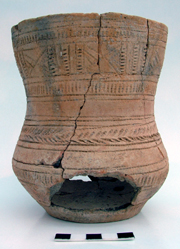
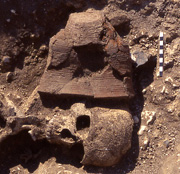
'Early Style Bell Beaker' from QEQM Margate
Photo by Susan Deacon (TTA)
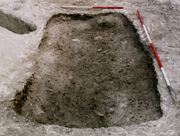
North Foreland burial coffin-structure soil-mark
Potential coffin-structures or evidence for coffins associated with Thanet Beaker burials have been suggested for the Manston, Monkton-Minster (3), North Foreland and QEQM Margate examples. All except the Manston and North Foreland burials have been flat graves. If one discounts all instances of uncertain or disturbed Beaker burials then six out of eight (75%) are likely to have contained coffin-structures.
The coffins are usually rectangular (the precise details of the Monkton-Minster graves are uncertain at present) and could have been formed of wooden planks (effectively a box) or possibly even wicker-work. Another option (particularly regarding the North Foreland and the QEQM burials) is that a hollowed log could have been used.
Beaker burials within wooden coffins are known from elsewhere, for example in

Roundhouses
By Dave Perkins and P.S.
Evidence of settlements of the Beaker period are rare, both locally and nationally. Recent large scale excavations around the Folkestone Eurotunnel site by Canterbury Archaeological Trust have revealed 15 sites yielding Beaker sherds and settlement evidence (reports forthcoming; Perkins 1999). This has helped to correct a statistical imbalance, for before this discovery over 95% of all East Kent Beakers were derived from non-domestic contexts (Nigel Macpherson Grant).
Probable
settlement sites in Thanet (represented by
Beaker sherds) may be found at Cottington, North Foreland,
However research conducted by Michael Allen (2005) over recent years has led him to conclude that a favoured location for Beaker settlements (in Southern England at least) may have been in valley bottoms (such as the Folkestone site mentioned above) and that as a result many may subsequently have been hidden beneath layers of colluvium (hill-wash). If so then many well preserved sites may await discovery!

Three Thanet Beakers
The Beaker phenomenon raises many questions. What controlled the distribution of Beakers and defined the boundaries of use (if any). Do the poorer quality vessels hint at some less skilled domestic potters emulating an elite Beaker using class? Is our understanding of Beaker use biased by the circumstances of our discoveries ?
Click here if you would like to link to a page which explores the significance of the Beaker legacy.
Arch Cant. - Archaeologia Cantiana, the annual journal of the Kent Archaeological Society.
KARU - Kent Archaeological Rescue Unit.
TTA - Trust for Thanet Archaeology.
TSMR - Thanet Sites and Monuments Record.
Version 1 - Posted 07.05.06
Version 2 - Posted 18.05.06
Version 3 - Posted 13.06.06
Version 4 - Posted 21.07.06
Version 5 - Posted 25.07.06
Version 6 - Posted 16.12.06